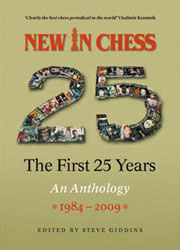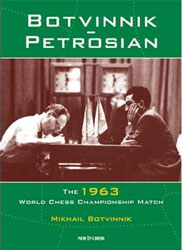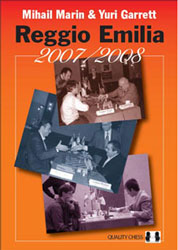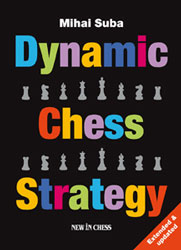John Watson Book Reviews (98)
History and General Works Part 3. John Watson Book Review #98
IM John Watson - Wednesday 12th January 2011

Dynamic Chess Strategy (2nd edition); Mihai Suba; | http://www.theweekinchess.com
In this new set of reviews and as a quick follow up to History and General Works Part 2 John Watson looks at: New in Chess: The First 25 Years An Anthology 1984 - 2009 edited by Steve Giddins, Chess Periodicals edited by Gino Di Felice, Botvinnik - Petrosian: The 1963 World Championship Match by Mikhail Botvinnik, Reggio Emilia, Dynamic Chess Strategy (2nd edition) by Mihai Suba and Instructive Modern Chess Masterpieces (2nd edition) by Igor Stohl.
In the last column, I reviewed the works of some favourite authors who have appeared on my ChessFM show. Here and in the next two columns I'll continue to discuss books which deal with history, strategy, and assorted subjects. You may have noticed that chess books are appearing in ever-growing quantities and coming from an increasing number of companies (which strikes me as in stark contrast to the rest of the book publishing industry). So the selections below are inevitably somewhat random. Nevertheless, of the scores of books that I've received or purchased, these all have positive qualities that I felt deserved attention. Some real duds have also come out, of course, and in general I'm not afraid to criticize books when they are of low quality. But amidst so many good books, I'd rather reserve negative assessments for publications that are truly incompetent, dishonest, or outrageously sloppy, and I haven't seen anything recently that merits such treatment. So let's be positive! Without further ado:

New in Chess: The First 25 Years An Anthology 1984 - 2009; Steve Giddins, editor; 398 pages; New in Chess 2010

Chess Periodicals, An Annotated International Bibliography, 1836-2008; Gino Di Felice; 349 pages; McFarland 2010

Botvinnik - Petrosian: The 1963 World Championship Match; Mikhail Botvinnik, 142 pages; New in Chess 2010

Reggio Emilia 2007/2008; 208 pages; Quality Chess 2009

Dynamic Chess Strategy (2nd edition); Mihai Suba; 208 pages; New in Chess 2010

Instructive Modern Chess Masterpieces (2nd edition); Igor Stohl 448 pages; Gambit 2009
Pretty much everyone agrees that New in Chess Magazine is the premier print magazine in the chess world. New in Chess: The First 25 Years An Anthology 1984 - 2009 is an extensive collection of articles that cannot fail to appeal to any chess fan. Those who have subscribed for parts of its life, or even those who have been reading it from its beginnings up to the present will still want to browse through this book and refresh their memories about certain events and time periods. Interviews which seemed fairly straightforward at the time take on more significance now, as will the results and descriptions of up-and-coming young players who were to find their way to the top levels of play. The collection puts quite an emphasis on interviews and general articles, which makes sense in that they feel more permanent than tournament reports. But there are plenty of the latter, including classic games annotated by world champions and other elite players. Naturally we find the world championships themselves described from a contemporary point of view, and the wonderful columns by Hans Ree and Genna Sosonko are a treasure. The book is edited (and compiled) by author Steve Giddins, who also provides an Introduction.

If you haven't read New in Chess very long (or at all), and if your interest in chess isn't strictly limited to the latest theory and improvement methods, you can't possibly go wrong with New in Chess: The First 25 Years. Even regular readers of the magazine will likely prefer taking this single volume off the shelf than digging through (messy stacks of?) individual issues.

Those who collect chess literature and/or do chess research are probably already aware of Gino Di Felice's impressive work Chess Periodicals, An Annotated International Bibliography, 1836-2008. If you aren't, take note of this unique contribution. In the book, Di Felice, the author of the colossal research project Chess Results (see numerous earlier columns), compiles an enormous list of chess magazines, periodicals, and similar publications, primarily those used and/or discovered during his research for the Chess Results series. In his words, the resulting bibliography "includes magazines, bulletins, newsletters, yearbooks, handbooks, almanacs, calendars, and other types of printed material published at regular intervals; online periodicals, which may become the source for a separate work, have been excluded." Di Felice passed my own severe test by listing the Colorado State Chess Bulletin, of which I was an editor in the mid-1970s - he actually lists a whole series of its editors, which is more than I could do. I suppose that periodicals in the form of VHS, CD, DVD, and future mediums will eventually make this list or get their own space; for now, however, I can only think of a few such, with ChessBase Magazine being easily the most thorough and long-lasting. There is, however, an ever-increasing list of online publications, of which our own The Week in Chess would have to be the most important and enduring example.

In column #95, I reviewed the New in Chess book Botvinnik - Smyslov, Three World Chess Championship Matches: 1954, 1957, 1958, consisting primarily of Botvinnik's notes. This year they also have given us Botvinnik-Petrosian: The 1963 World Championship Match. Botvinnik's son Igor has compiled the material, and attributes the authorship to his father (Mikhail Botvinnik), although in fact Botvinnik annotates only seven of the games. The others are annotated by various grandmasters, including five by Akopian (specifically for this book),two by Petrosian, two by Panov, one by Korchnoi, one by Kotov, one by Bagirov, one by Flohr, one by Taimanov, and even one by Kasparov (using his notes in Predecessors)! Unfortunately, with the exception of Kasparov and Akopian, it isn't clear from which books or magazines the commentaries were taken, or in which years they were written.
This has been a forgotten match in many respects. Petrosian's defeat of Botvinnik ended Botvinnik's 15-year-long participation in World Championship events, and Petrosian went on to become one of an elite class of players to win two World Championship matches in a row (something which, for example, Capablanca, Euwe, Smyslov, Spassky, and Fischer failed to do). The games in the 1963 match were generally hard-fought affairs of a highly technical variety - you won't see many of them in anthologies or middlegame books, and the openings weren't of exceptional significance even at the time. Looking back, we have been spoiled by the magnificent battles of Kasparov and Karpov, and expect World Championships to be knock-down affairs with positions of extraordinary complexity. Yet someone looking to learn about how to handle 'normal', partially simplified positions, and endings with just a few pieces, will find plenty of material here (as well as in the Botvinnik-Smyslov matches). It might be interesting to put an engine on the games to see how accurately they are played, and how many opportunities were missed, because the notes are in a traditional and rather spare style. Incidentally, there is a 4-part video on Game 18 of the match on ChessCafe.com (in the video section).
A significant part was played by the Queen's Gambit Accepted, with which Petrosian secured seven draws. After five games with 3 Nf3 Nf6 4 e3 c5 5 Bxc4 e6 6 0-0 a6 7 a4, Botvinnik finally changed course and tried 7 Bb3, when Bagirov comments that it is 'clearly not the best move in the position'. This shows how the times have changed, since 7 Bb3 is now considered one of the biggest threats to the QGA, and probably the most important move.
One of the highlights of the book is an article by Petrosian about his preparation for the match in the months leading up to it. He says many interesting things, e.g., 'I have always suffered from a rather casual handling of the opening.' That could also have been said about Spassky, and both were caught up short by the ultra-theoretical Fischer. Today we have no 'casual' handlers of openings amongst the world's elite. Petrosian says that the prevailing view of Botvinnik was that he was weak in tactics, and that supposedly you should pick sharp openings against him. But Petrosian "noticed how many brilliant tactical victories" Botvinnik had achieved, so he adopted the (successful) philosophy of "play normally and don't fear simplification". Also from Petrosian: "I am not one of those players who is able to come out the day after a defeat and play with redoubled energy." Perhaps the only modern champion of whom we could say this?
The book also includes other games between Botvinnik and Petrosian, and a section of opening notes by Botvinnik in preparation for the match. I think that I can safely say that this book will appeal to those who love chess history (and the world champions). Most active players, and certainly younger ones, will probably want to look elsewhere for their chess reading; but anyone who puts some time into this book will benefit from it.

It seems as though everyone who writes about Reggio Emilia 2007/2008 bemoans the declining numbers of tournament books and praises their virtues. I agree with them, but I also understand that it takes a compelling story to attract a significant number of customers. The games from the 'everyday' elite tournaments tend to be extensively analysed as they are being played (online, live, with computers and commentators), then again in the next day's publications, and again as various articles appear, by which time many of us have downloaded fully annotated copies. That doesn't mean you couldn't sell books on these tournaments, but unless they involve the world championship it will be hard to convince many fans to invest their limited budgets in them. In publishing Reggio Emilia 2007/2008, Quality Chess has tried out an alternative that deserves attention and hopefully success. After all, very few people, even serious chess fans, will have followed the games and drama of this event as they unfolded in real time. So the potential reader will get a fresh and unfiltered view of a unique high-class tournament, contested by a group of non-superstar grandmasters duking it out. Not that this group is far from the top (the average rating looks around 2660). Although the names may not be blockbusters, TWIC readers will be familiar with some of these: Zoltan Almasi (the winner, with 6 points), Ni Hua, Gashimov and Harikrishna (all at 5.5), as well as Tiviakov, Godena, Korchnoi, Landa, Navara, and Marin.
The great majority of the games are annotated by Marin, sometimes at great length, and the Introduction, tournament information, and round-by-round descriptions are written by Yuri Garrett. Most of players annotate at least one game, even Korchnoi, and there's a special section of games by Ni Hua at the end. The book includes an interview of Ni Hua and Harikrishna simultaneously, and a retrospective of 50 years of the Reggio Emilia event (this was the 50th edition). One of the high points for me, as a browser, was an amazing article about Korchnoi's handling of minor piece endings in which he had a bishop and knight versus two bishops. This follows a game between Marin and Korchnoi (drawn) with the same material distribution. Afterwards, Marin looked at three of Korchnoi's games, and one game Portisch-Darga, and in the book shows how Korchnoi manages to draw two games, and even win one, with the theoretically inferior bishop-and-knight pair. Fantastic stuff!
This is an original and high-quality project that will make for fun reading today, next year, or twenty years from now.

Mihai Suba's wonderful book Dynamic Chess Strategy first appeared in 1991. I have a bedraggled copy of that old Pergamon edition, which I suspect is not easy to find a copy of. Fortunately, it has been released in expanded form by New in Chess; this edition has the same games with the same notes, only slightly updated, and a lengthy new Chapter 1 with commentary and 16 quizzes (answers at the end of the book). A minor complaint: the new material could use a great deal of editing. There are several grammatical problems, but also misused words and constructions which just don't make sense, i.e., even Suba's intended meaning isn't evident. This doesn't gibe with the usual thoroughness with which New in Chess operates; but there is no editor listed, only a proofreader, who presumably was looking at such things as diagrams and spelling. On a practical level, fortunately, it doesn't matter much, since the original annotations to the games (from the older edition) are well-edited and clear. Nevertheless, just a few hours review the author's new material could have fixed this.
As someone who cited Suba's wit and wisdom, as well as his fascinating games, in my book Secrets of Modern Chess Strategy, I looked forward to his new comments. In a section called 'An Answer to John Watson', he plays off a specific rhetorical question I posed, and uses it to discuss the meaning (or meaninglessness) of words like 'modern', 'classical', and 'hypermodern'. His general comment is "What would you say if we cut down the bad jargon…and round off in a nice way?" Fair enough, although we writers do love these romantic characterisations, to which Suba is not immune. Elsewhere, in the chapter 'Black Wins After All', he takes issue with my statement "Of course, Suba himself scores better with White", saying that it isn't true. But in about 2400 games in my database, he has a 68%-32% record with White and 60%-40% with Black, with a considerably higher performance rating advantage when White.
In general, and I think to his credit, Suba doesn't seem to have backed off from the philosophy or observations that he advanced 20 years ago. As for the bulk of the book - the original games and notes - his humour is still fresh, and his insights ring as true today as they did at the time. This is a chess classic in which every aspiring player can find inspiration and wisdom.

Another classic book (although only ten years old) is Igor Stohl's Instructive Modern Chess Masterpieces. This is a much more 'serious' book (in the traditional sense) than Suba's, with little of the colour and flair that we see in the latter. Stohl tears apart 62 of the best top-level games since 1993, using 446 large pages to analyse them in detail reminiscent of some of Kasparov's analysis and even Huebner's. Apart from some advanced opening works, we aren't seeing many such technical books today; at times this has almost a scholarly feel. The game summaries (which are fairly thorough and not merely a perfunctory paragraph or two) help balance that approach. They explain the game in more general strategic terms, identifying crucial turning points. This makes the games more accessible to the amateur, although it should be said that the complexity of the analysis and the knowledge that Stohl expects of the reader would require an unusual effort from anyone rated 1800 or below (that is, for that player to fully profit from the book). Another way to think about this is that the average player would probably have to use this as his or her only study material for several months, and be prepared to give it undivided attention. In that context, be aware too that the opening variations of these games tend to be modern and very dynamic, and the recent games include highly fashionable and theoretical openings, so if you like classical lines or a slow-developing game, the book might not best suit your needs.
That said, anyone who enjoyed the previous edition, which sold very well, should probably get this one too. Like Kasparov, Stohl updates the analysis of the older games. More importantly, he has added 12 new contests from 2000-2007 and 128 new pages; you see what density of analysis that implies. In conclusion, Instructive Modern Chess Masterpieces is an excellent effort which should be considered one of best serious games collections of the past ten years. It demonstrates what modern, dynamic chess is about, and does so via the medium of rich and attractive games. Just keep in mind that the book may be a bit too advanced for average players, especially those who are more interested in study for improvement than they are in enjoyment and appreciation.


 TWIC is 30. First issue 17th September 1994.
TWIC is 30. First issue 17th September 1994.




